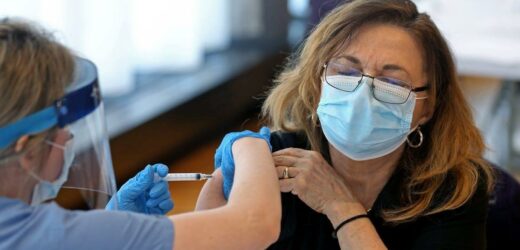- Coronavirus vaccines are proving just as effective in real life as they were in clinical trials.
- That indicates that the vaccines are holding up well against variants.
- In Pfizer’s case, the shot also seems to yield fewer side effects than in clinical trials.
- See more stories on Insider’s business page.
By the time coronavirus vaccines were rolled out to the public, tens of thousands of people had already received their shots in clinical trials.
The results of those studies gave us a good sense of how well the vaccines worked: Pfizer’s was found to reduce the risk of getting COVID-19 by 95%, while Moderna’s had an efficacy of 94.5%. Johnson & Johnson’s single-dose shot, meanwhile, was found to cut the risk of infection by 66% globally — and by 72% among US trial participants.
But the three trials were difficult to compare side by side, since they happened at different stages in the pandemic and in different geographic regions.
Now, real-world studies are beginning to offer a clearer picture of how well the vaccines perform outside trials and in the face of emerging variants.
For the most part, it’s great news: Pfizer and Moderna’s vaccines seem to be just as effective in real life as in their trials.
A new report from the Centers for Disease Control and Prevention showed that the two shots, as a whole, reduced the risk of getting sick with COVID-19 by 94% among 500,000 healthcare workers who were fully vaccinated.
Recent studies have also found that both shots prevent asymptomatic infections, a result that wasn’t yet known when the trial data came out.
A March CDC report found that Pfizer and Moderna’s shots were 80% effective at preventing coronavirus infections — with or without symptoms — after just one dose, and 90% effective after two doses.
Similarly, an Israeli study found that Pfizer’s vaccine was 94% effective against asymptomatic infections. That’s likely a sign that the shots reduce transmission.
J&J’s shot also seems to be matching its trial results in real life.
A recent study, which is still awaiting peer review, found that J&J’s shot was about 76% effective at preventing all coronavirus infections. (Clinical trials suggested it was 74% effective at preventing asymptomatic infections.)
The study’s sample size was small, however: around 1,800 patients observed at The Mayo Clinic from February to April. Just three of those individuals tested positive for the coronavirus 15 days or more after getting vaccinated.
Together, all three shots have proven so effective that the CDC announced on Thursday that fully vaccinated Americans may participate in any kind of activity — large or small, indoor or outdoor — without wearing a mask or physically distancing.
“It really underscores how confident we are in these vaccines and the ability of these vaccines to really protect people,” Anne Rimoin, an epidemiology professor at the University of California, Los Angeles, told Insider.
Vaccines are holding up well against variants
As coronavirus variants began to circulate widely in December, some scientists worried that Pfizer’s or Moderna’s shots would stop performing as well as they did in the summer and fall. That’s because the companies’ late-stage trials took place from July to November, when new coronavirus variants weren’t as prevalent.
By contrast, J&J’s late-stage trial took place slightly later in the pandemic, from September to January. The trial also included participants who got infected with B.1.351, a variant first identified in South Africa. The variant has been shown to partially evade antibodies generated in response to vaccines or prior natural infections.
But a large study of Pfizer recipients in Israel suggests that new variants haven’t diminished the vaccine’s effectiveness. From January to March, the Israel Ministry of Health collected data from millions of people who were vaccinated with Pfizer’s shot. By that time, B.1.1.7, a more contagious variant first discovered in the UK, was the dominant strain in Israel.
Pfizer’s vaccine was still found to be at least 97% effective against symptomatic COVID-19 cases, hospitalizations, and deaths.
Pfizer’s shot has also performed well against variants in Qatar: New research found that people in Qatar who were fully vaccinated with Pfizer’s shot were 75% less likely to get a COVID-19 case caused by the B.1.351 variant than unvaccinated people were. They were also around 90% less likely to develop COVID-19 caused by the B.1.1.7 variant discovered in the UK.
“The vaccines that we have so far seem to be effective against most of the variants, if not all the variants, they’ve really been tested against,” David Dowdy, an epidemiologist at the Johns Hopkins Bloomberg School of Public Health, told Insider.
Pfizer’s side effects may be less common in real life
Coronavirus vaccines have generally produced mild, short-lived side effects both in and out of clinical trials. But emerging evidence suggests that Pfizer’s side effects may be less common in real life.
Around 63% of participants in Pfizer’s clinical trial reported fatigue, while 55% reported headaches and 38% reported muscle pain. But after 28,000 Pfizer recipients recorded their side effects in an app, UK researchers analyzed the data and found that less than 15% of people reported fatigue after either their first or second dose. Similarly, less than 14% of the people self-reported headaches and 5% or less reported muscle pain after either their first or second dose.
In J&J’s case, however, rolling out the vaccine to the public revealed a very rare side effect that wasn’t spotted in clinical trials. As of Wednesday, the CDC had identified 28 cases of thrombocytopenia syndrome — a rare combination of blood clots and low platelet counts — among 8.7 million recipients of J&J’s vaccine.
“When you start vaccinating people, you have a much, much, much larger sample size — in the millions,” Dr. Vivek Cherian, an internal-medicine physician in Baltimore, previously told Insider. “So when you have these exceedingly rare complications, sometimes you don’t see that until you actually start.”
Since the clotting cases are around 3 in 1 million so far, the CDC has said the benefits of J&J’s shot far outweigh the risks. But the vaccine’s label now warns that the shot may pose an increased risk of clotting, particularly among women under 50.
This story has been updated with new information. It was originally published May 13, 2021.
Source: Read Full Article


